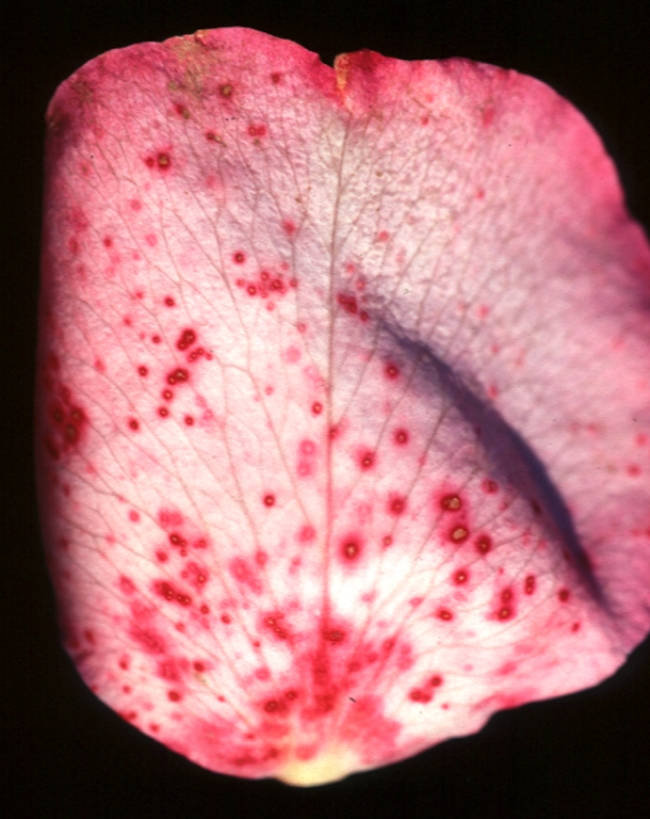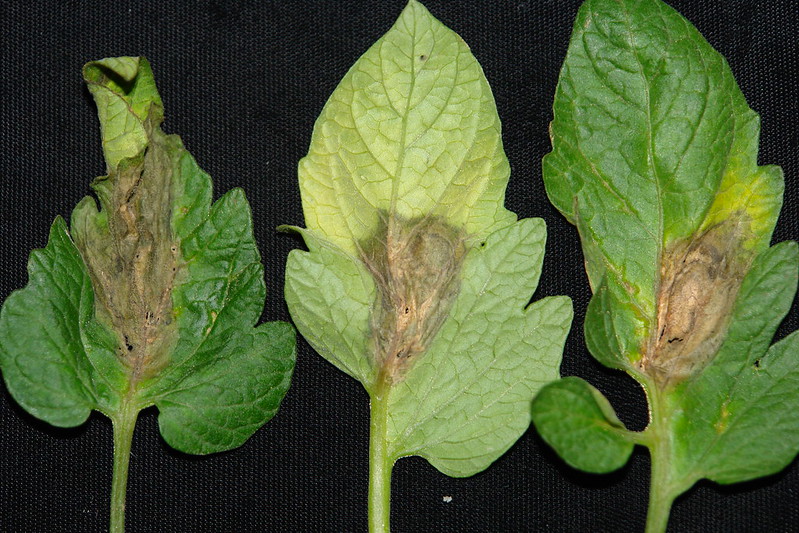Controlling Botrytis/Grey Mold
The focus of this blog post is Botrytis cinerea, also known as grey mold. Worldwide, this fungus causes annual losses between $10 billion to $100 billion value in crops worldwide [3]. Pathogen Profile provides a concise summary of a plant pathogen that growers are interested in. See our Resource page to see what we aim to cover in each post.
What is Botrytis cinerea?
Botrytis cinerea (also known as botrytis bunch rot, botrytis blight, or grey mold) is a necrotrophic fungus [9]. It can appear on over 200 different plant species including tomato, peppers and lettuce in a greenhouse. B. cinerea causes grey mold which is evident on the surface as grey fluffy mycelium as pictured in Figure 1. Check out our blog on Pythium, another plant disease that causes major crop loss.
Necrotrophic fungus: a fungus that first kills the host, then survives off the nutrients of dead plant tissue.
Mycelium: The root-like structure of a fungus consisting of a mass of branching, thread-like hyphae.

Infection and Symptoms
When the shoot system of the plant is infected with grey mold, spores will spread from the affected areas to the non infected areas. These spores can spread through moisture in the air and air currents from plant to plant [6]. B. cinerea can infect a plant at any stage of growth, from tiny seedlings to large, mature plants. However, new succulent growth, freshly injured tissues and older or dead plants are favored by the fungus [10]. The disease first appears as lesions on leaves and stems, which quickly produce the characteristic grey, furry mycelia, this can be seen in Figure 1. As the disease progresses the mycelia will continue to grow and encircle stems and leaf petioles, eventually, this will lead to plant collapse [8]. Depending on the crop, usually takes two to three weeks to become visible [2].

Symptoms of Botrytis species often appear as grey in colour, soft, mushy spots on leaves, stems, flowers and on produce [8]. Affected areas can be covered by a layer of grey fungus spores, especially in environments where humidity is high. Once infected, fruit or plants will shrivel up and rot. They also often develop black, stone-like sclerotia under rotted parts [8].
Sclerotia – a compact mass of hardened fungal filaments
Grey mold can also form on flower petals as seen in Figure 3, especially under growing conditions where there is high humidity and moisture. Infection of flower petals leads to rapid disease development in young fruit, where the fruit tissue will quickly turn into water soaked spots [10].

Is this article helpful so far? Subscribe to our newsletter to get more, up-to-date information about pathogens and solutions.
Can Botrytis Cause Harm to Humans?
Botrytis has not been reported as a human pathogen. However, it is known as allergenic precipitants of asthma and hypersensitivity pneumonitis. There have been two clinical studies that reported an association between asthma and positive skin prick test reaction to molds including B. cinerea [7].
Growth Conditions
Table 1. Growth conditions for Botrytis cinerea [2]
| Optimal Condition | |
|---|---|
| Environmental | High humidity (93% and above) |
| Temperature | 50° to 60°F (10°C to 15°C) |
Botrytis cinerea in Hydroponic Systems
B. cinerea has a range of hosts from tomatoes to geraniums. A few common hydroponic plants which are naturally susceptible to botrytis include tomato, cucumber and leafy greens [1]. B. cinerea is a very persistent fungus and if immediate measures such as use of fungicides to control the disease are not taken at the first sign of infection, serious crop losses can occur [5]. The best ways to manage infection and disease are early detection and proper climate control [5].
Worldwide, this fungus causes annual losses between $10 billion to $100 billion value in crops worldwide [3].
susceptible: an organism’s ability to suffer if exposed to a particular threat.
Preventative Measures: Botrytis cinerea in Hydroponic Systems
- Make sure the air is moving. Growers must ensure that the air is constantly moving at the plant’s surface to reduce the risk of infection. In normal conditions, the air is moved at the top of the greenhouse. It is important to establish vertical airflow as well as horizontal airflow [5].
- Constantly monitor humidity and moisture levels. In order to avoid condensation on plant surfaces it is important to pay attention to the relative humidity and temperature. One way to know whether the humidity is correct in your controlled environment is to pay attention to the dew point for your temperature and humidity. In the morning, if droplets are dripping from the roof of the greenhouse, it means that dew has formed on the cooler plastic and your plants are at risk of botrytis infection [5].
Disclaimer:
The information we present in Pathogen Profile is based on collating published peer-reviewed scientific literature and sources we think are reliable. This is by no means an exhaustive review of pathogens. Pathogen Profile gives a small glimpse of what is known about pathogens and we encourage growers to do more research on their own based on the pathogens in relation to their own crops and hydroponic systems. The information presented in Pathogen Profile is for educational purposes and should not be used as professional advice to treat pathogens or to operate your hydroponic system.
Works Cited
[1] Battling Botrytis | Cropking (n.d.). Retrieved March 19, 2022, from https://cropking.com/blog/battling-botrytis
[2]Botrytis Cinerea: a highly infectious crop killer – in detail | CANNA Gardening USA. (n.d.). Retrieved March 21, 2022, from https://www.cannagardening.com/botrytis_cinerea_in_detail
[3]Boddy, L. (2016). Pathogens of Autotrophs. The Fungi: Third Edition, 245–292. https://doi.org/10.1016/B978-0-12-382034-1.00008-6
[4] Chai, A. L., Ben, H. Y., Guo, W. T., Shi, Y. X., Xie, X. W., Li, L., & Li, B. J. (2020). Quantification of Viable Cells of Pseudomonas syringae pv. tomato in Tomato Seed Using Propidium Monoazide and a Real-Time PCR Assay. Plant Disease. https://doi.org/10.1094/PDIS-11-19-2397-RE
[5] Gagandeep Singh Bhatoa & Dr. Mohyuddin Mirza. Managing Botrytis: A serious disease in greenhouse lettuce | Greenhouse Canada. (August 13, 2019). Retrieved Mar 20, 2022, from https://www.greenhousecanada.com/managing-botrytis-a-serious-disease-in-greenhouse-lettuce-33048/
[6] Gray Mold (Botrytis): Symptoms, Treatment and Control | Planet Natural. (n.d.). Retrieved March 19, 2022, from https://www.planetnatural.com/pest-problem-solver/plant-disease/gray-mold/
[7] Hashimoto, S., Tanaka, E., Ueyama, M., Terada, S., Inao, T., Kaji, Y., Yasuda, T., Hajiro, T., Nakagawa, T., Noma, S., Honjo, G., Kobashi, Y., Abe, N., Kamei, K., & Taguchi, Y. (2019). A case report of pulmonary Botrytis sp. infection in an apparently healthy individual. BMC infectious diseases, 19(1), 684. https://doi.org/10.1186/s12879-019-4319-2
[8] Rigling, D., Robin, C., & Prospero, S. (2021). Mycovirus-Mediated Biological Control. Encyclopedia of Virology, 468–477. https://doi.org/10.1016/B978-0-12-809633-8.21516-1
[9] Williamson, B., Tudzynski, B., Tudzynski, P., & van Kan, J. A. L. (2007). Botrytis cinerea: the cause of grey mould disease. Molecular Plant Pathology, 8(5), 561–580. https://doi.org/10.1111/J.1364-3703.2007.00417.X
[10] Y. Elad and G. Zimand. (1992). Integrated biological chemical control of grey mould. Recent Advances in Botrytis Research, April, 272–276.
Looking for more useful info? Go back to the Blog Page or checkout the Resources Page.
![]()
Tanya is a bioinformatician and pathogen expert. To learn more about different pathogens in your farm, click the button below.




